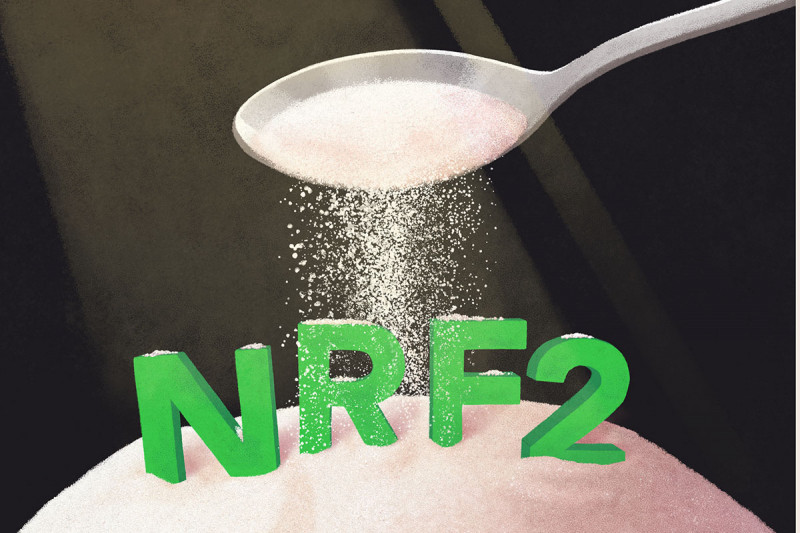
Scientists have discovered a surprising role for sugar: as a control knob for protein function. Image credit: Samantha Welker
Mutations in genes drive many cancers. One of the most commonly mutated genes in cancer is NRF2. Up to 30% of solid tumors, including lung, liver, bladder, head and neck, and esophageal cancers, have mutations in this gene.
The normal role of the protein made from NRF2 is to protect cells against dangerous by-products of metabolism called reactive oxygen species. Cancer cells co-opt this role, using the NRF2 protein as a kind of shield to safeguard their growth.
There is great interest among scientists in developing drugs that could block NRF2’s action. But NRF2 belongs to a class of proteins called transcription factors, which historically have been considered “undruggable.”
A team of researchers at the Sloan Kettering Institute may have cracked the nut. In a recent study, reported on August 8 in the journal Cell, they discovered a new and surprising control knob for NRF2 action in cancer cells: Sugar molecules attach themselves to NRF2’s binding sites, effectively shutting it down. These sugar molecules must be removed before NRF2 can act. The enzyme that removes the sugars is called fructosamine-3 kinase (FN3K).
“Cancer cells depend on the enzyme FN3K to remove these sugars, and that is a weakness we can use against them,” says Hans-Guido Wendel, a member of the Cancer Biology and Genetics Program at SKI and the principal investigator of the study.
FN3K is the only enzyme in the human genome that can remove sugars from proteins. Without it, Dr. Wendel says, cancer cells can no longer grow, making FN3K an attractive potential drug target.
Using CRISPR to Identify the Key Regulators of NRF2
The researchers made their discoveries about NRF2 with the help of the genome-editing tool CRISPR. First, they introduced mutations into the NRF2 gene and showed that these mutations lead to aggressive liver cancers in mice. Next, they used CRISPR to introduce mutations across the genome in mice, in an attempt to identify any change that prevented NRF2-driven liver cancers from growing. FN3K stood out as a key player.
The team examined how FN3K affected NRF2 and found that in cells lacking FN3K, the NRF2 protein is extensively decorated with sugar molecules, specifically glucose. The investigators found that these sugars block NRF2’s function. Cancer cells that cannot remove these sugars do not survive. The process of adding sugars to proteins is called glycation.
“This is the first time that anyone has shown that cellular proteins are glycated by glucose and that this can directly affect protein function,” says Viraj Sanghvi, a postdoctoral research fellow in the Wendel lab and the paper’s first author.
Glycation has been studied extensively in diabetes. Hemoglobin A1c, which is used to monitor blood glucose control, is the glycated form of hemoglobin. That glycation can control key proteins in cancer cells is a completely novel finding and “opens up a whole new avenue of research,” Dr. Sanghvi says.
A Potential Treatment Strategy
Of particular interest to cancer biologists is the possibility that this discovery could lead to better treatments.
“Small molecules that inactivate FN3K would leave NRF2 in the glycated, inactive state and, therefore, deprive the cancer cells of a shield they need to survive,” Dr. Wendel explains.
NRF2 is not only involved in driving cancer growth, it has also been implicated in the development of chemotherapy resistance in lung cancer and other tumors. A drug that inactivates NRF2 would be a boon to people with several types of cancer.
“Given how common these mutations are in cancer, there is an urgent need to develop inhibitors of the NRF2 pathway,” Dr. Sanghvi says. “Knowing the pivotal role played by glycation is an important first step toward that goal.”
The team is now working on drugs that will block FN3K and improve cancer therapies.
They stress that their findings do not translate into recommendations for changes to the consumption of dietary sugars. Cancers consume high amounts of sugars regardless of what people eat.

